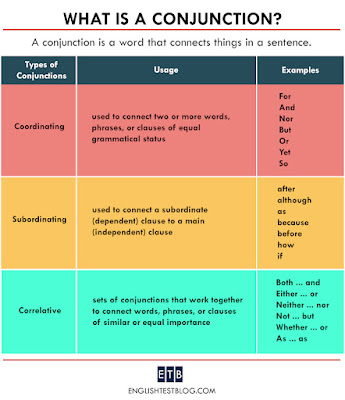Conjunctions are important because they help us to express relationships between different parts of a sentence. Sentences without conjunctions are often short and brief. They add that extra power and richness to our sentences.
What is a conjunction?
A conjunction is a word that connects things in a sentence—words to words, phrases to phrases, or clauses to clauses. The word "and" is one of the most used conjunctions. Look at the examples of how to use a conjunction to connect these words, phrases, and clauses.
- I like pizza and pasta. (connects two words)
- She enjoys reading books and watching movies. (connects two phrases)
- The rain stopped, and a rainbow appeared in the sky. (connects two clauses)
Types of conjunctions
There are three main types of conjunctions: coordinating conjunctions, subordinating conjunctions and correlative conjunctions
Coordinating conjunctions
Coordinating conjunctions connect two or more words, phrases, or clauses of equal grammatical status. There are seven coordinating conjunctions in English. Each of these conjunctions is a single syllable, and relatively short in length.
- and, but, for, nor, or, so, yet
Comma
If you have two complete sentences (independent clauses) joined by a coordinating conjunction, use a comma before the conjunction.
- I wanted to go to the movies, but it was raining outside.
- She enjoys painting, and he likes to play the guitar.
If the coordinating conjunction connects single words or short phrases that are not independent clauses, a comma is usually not necessary.
- She likes coffee and tea.
- He can swim or dive.
To remember the coordinating conjunction, you can use the acronym "FANBOYS". Each letter in "FANBOYS" corresponds to one of the seven coordinating conjunctions.
- For
- And
- Nor
- But
- Or
- Yet
- So
Subordinating conjunctions
Subordinating conjunctions are used to connect a subordinate (dependent) clause to a main (independent) clause. Here are some common subordinating conjunctions
- after, although, as, because, before, how, if, once, since, than, that, though, till, until, when, where, whether, while
Look at the example sentences:
After: She went to the gym after she finished work.
- Main clause: She went to the gym
- Subordinate clause: after she finished work
- Main clause: they decided to have a picnic
- Subordinate clause: Although it was raining
- Main clause: I was late
- Subordinate clause: because the traffic was bad
If: If you finish your homework, you can go out to play.
- Main clause: you can go out to play
- Subordinate clause: If you finish your homework
A main clause is a complete and meaningful sentence on its own. A subordinate clause cannot stand alone as a complete sentence. It relies on the main clause to make sense in context.
Subordinating conjunctions always come at the beginning of a subordinate clause. It serves as a signal that more information is coming. For example:
She read a book before she went to bed.
- Subordinating conjunction: before
- Subordinate clause: before she went to bed
However, the position of the subordinate clause in a sentence can vary. It can come after or before the main clause. For example:
Before she went to bed, she read a book.
- Subordinate clause: Before she went to bed
- Main clause: she read a book
Correlative conjunctions
Correlative conjunctions are sets of conjunctions that work together to connect words, phrases, or clauses of similar or equal importance. Some of the most common correlative conjunctions are:
- Both ... and
- Either ... or
- Neither ... nor
- Not ... but
- Whether ... or
- As ... as
Look at the example sentences
- The garden is both colorful and peaceful. (Two adjectives are connected.)
- You can either go to the store or order online. (Two verb phrases are connected.)

Comments
Post a Comment